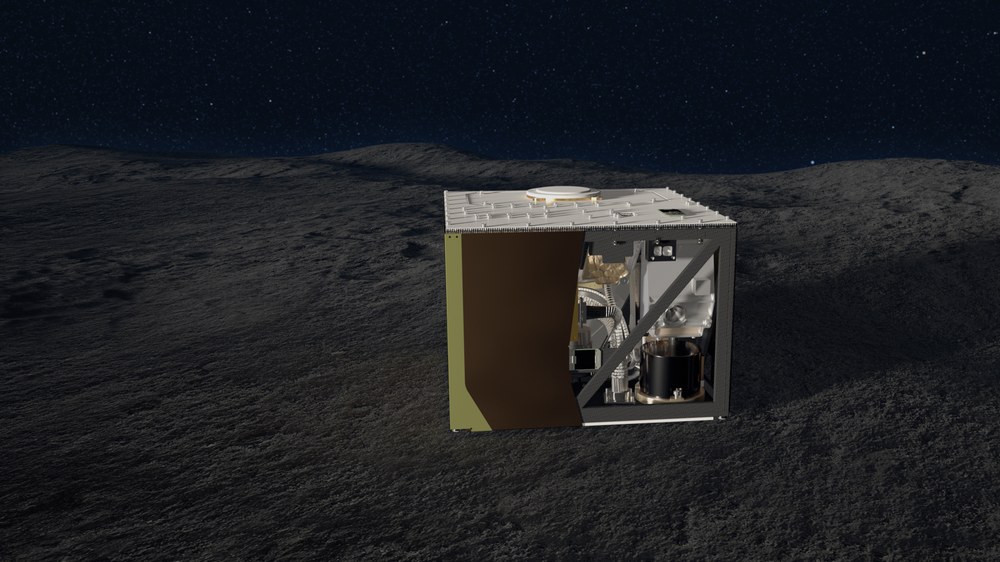Hayabusa2/Hayabusa2#

The Japan Aerospace Exploration Agency’s (JAXA) Hayabusa2 asteroid sample return mission was launched to the km-sized C-class asteroid (162173) Ryugu on 3 December 2014 and arrived on 27 June 2018. DLR developed and operated Hayabusa2’s MASCOT asteroid lander in cooperation with the French CNES. MASCOT landed on the asteroid on 3 October 2018 and carried out a detailed scientific investigation of the asteroid in situ studying the asteroid’s geology, magnetization, and physical surface properties. Samples were taken by the Hayabusa2 spacecraft at two locations and have been returned to Earth on December 6, 2020.
MASCOT operated on Ryugu for 17 hours (two Ryugu days), and MASCam, the MASCOT Camera, took images during decent and on the surface with resolutions down to 0.2 mm/pixel, revealing two different types of boulders on the surface. High-resolution images revealed the fine structure of a boulder and identified small sized inclusions. Using MASCam’s LEDs the inclusion size distribution and spectral slope were determined and showed that the texture of the rock on Ryugu is similar to carbonaceous chondrites (Schröder et al., 2021). The surface roughness extracted from MASCam images appeared to be less than that of comet 67P hinting at different alteration processes on the surfaces of asteroids and comets (Otto et al., 2021). The MASCOT radiometer MARA took continuous temperature measurements, indicating a thermal inertia much lower than anticipated based on measurements of chondritic meteorites, indicating high boulder porosity (Hamm et al., 2020). MARA results were later confirmed by the Haybusa2 orbiter thermal infrared instrument (Okada et al., 2020), and modeling supports the formation of Ryugu from highly porous material (Grott et al., 2020, Neumann et al., 2020). Besides providing MASCOT and delivering two PI-Instruments (MASCam, MARA), DLR is involved in geological and geophysical data analysis, including Co-I contributions to the Hayabusa2 Orbiter instruments. DLR further significantly contributed to the MASCOT operations planning (Lorda et al., 2020). Since August 2022 a grain returned from asteroid Ryugu was allocated to the department Planetary Laboratories for laboratory analysis. FTIR, µ-FTIR and Raman investigation has been already carried out. Together with the MfN (Museum für Naturkunde) chemical and elemental analysis are carried out actually. Due to the exceptional results already achieved on the grain at the Planetary Spectroscopy Laboratory, JAXA agreed to extend the sample loan until end 2023.
After the successful delivery of samples to Earth, the Hayabusa2 spacecraft continues its journey through the solar system. The mission has been renamed Hayabusa2# (read: Hayabusa2-SHARP), i.e. the Hayabusa2 Small Hazardous Asteroids Reconnaissance Probe. The spacecraft is currently on its way to the approximately 500 m diameter S-type asteroid 2001 CC21, which it will pass by in 2026. Finally, Hayabusa2# will rendezvous with the extremely fast rotating asteroid 1998 KY26 in 2031 and will study this likely monolithic body in great detail.
Hardware Participation of the DLR Institute of Planetary Research
- MASCam (MASCOT-Camera)
PI: Ralf Jaumann - MARA (MASCOT-Radiometer)
PI: Matthias Grott
Scientific Participation of the DLR Institute of Planetary Research
- MASCam (MASCOT-Camera)
- MARA (MASCOT-Radiometer)
- TIR Camera (Thermal Infrared Imager)
- ONC (Optical Navigation Camera)
- MMEGA (µ-OMEGA on MASCOT)
Further DLR Participation
Institut für Raumfahrtsysteme
